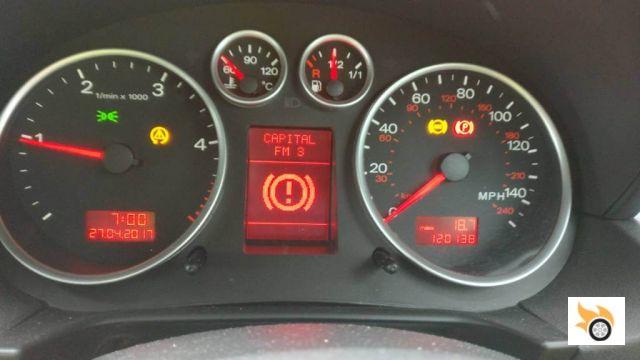
What is the brake light of the car?
The brake light is one of the most important car lights that you should always have under control and that is why you have to keep in mind what the brake light is. From a graphical point of view we see it represented by an exclamation mark in a circle between two brackets.
The brake light is almost red and lights up constantly. In some cars we also find it flashing and this can indicate the presence of a serious anomaly in progress.
Given its importance, the brake system has three different lights dedicated to the various parts that make it up. In addition to the brake light, we also have the parking brake light (a P inside a rim in brackets) and the brake pad wear light. The latter comes on if the brake pads are excessively worn and it's time to change them.
What does the brake pad wear indicator light on the car mean?
As we explained before, the brake system has three different warning lights that cover all the possible anomalies that can arise and cause braking problems. It goes without saying that a car with braking problems becomes a very dangerous car to drive, both for motorists and other road users.
Handbrake actuation and related problems are covered by the handbrake warning light. Brake pads and brake pad wear are covered by the brake pad warning light. This means that the brake system is not affected by any other possible brake system faults.
Why did my car's brake light come on?
A brake light on almost certainly indicates a problem with the brake system. The most common problems with the brake system are as follows:
- Low brake fluid level - the brake fluid or brake oil, so that the brake calipers squeeze every time the brake pedal is pressed. The brake fluid circuit is watertight, but leaks can occur due to damaged or worn parts. To find out more about this cause of the brake fluid warning light, we recommend you take a look at the article on when to change the brake fluid.
- False contactor problem with the control unit - sometimes the brake light of the car only comes on due to a simple faulty electrical contact that sends a signal to the control unit. In this case the brakes are fine and you just need the mechanic to turn off the brake light.
- Problem withthe brake fluid reservoir float - this problem is more common in classic cars than in modern ones. The float may be stuck and indicate an incorrect brake fluid level. In this case it is up to the mechanic to repair or replace the float.
What to do if the brake light stays on?
If the brake light comes on and stays on, there may be a malfunction in progress. To avoid continuing to drive a potentially dangerous car, we recommend the following procedure:
- Turn the engine off and shut it down.
- Find out where the brake pump (pushing the fluid in causes the brake pads to squeeze) and the brake fluid container are located (you'll find it in your car's owner's manual). Normally the container has a yellow cap with the same symbol you see on the warning light.
- Check the brake fluid level, top up if it is below the minimum level. As with the engine oil, each car model requires a particular type of fluid, remember to use the right one for your car.
- Get back in the car and start the engine
If the warning light disappears it means that the problem was caused by low brake fluid. If after all this work it's still on, there's most likely a problem with a contact, perhaps due to a damaged fuse. Getting back on the road should not cause any damage, however, once you have reached your destination, we recommend that you check the brake fluid level again.
If you notice that it has dropped again, even slightly, there is almost certainly a leak in the brake system and you will need to get your car back to the garage as soon as possible. If you choose to ignore the warning light and the brake fluid drops too low, you may lose control of the car next time and cause an accident. If it were me, I'd go to the mechanic right now.
If the disc brakes on your car have recently been replaced, you may also want to check the brake calipers and make sure they are set correctly. An improperly mounted disc brake caliper could be the cause of a brake fluid leak.


























